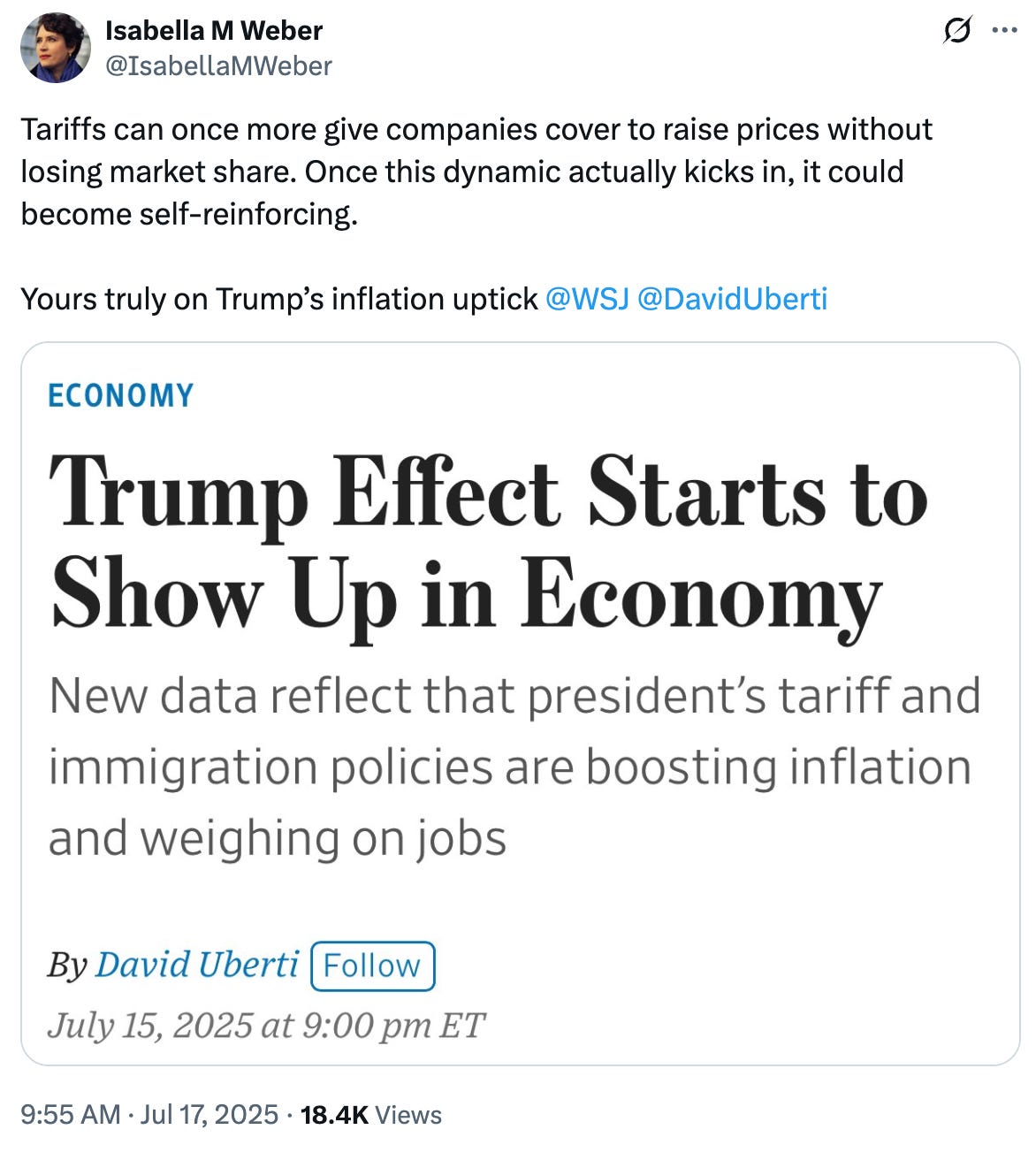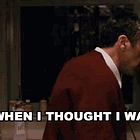Will tariffs cause greedflation?
An upcoming test against supply and demand
I think we finally have it: a test of greedflation.
Okay. That’s not quite true. Greedflation has always been too vague to qualify as a theory. But there has been a broad class of explanations of inflation that point to similar mechanisms that aren’t just simple supply and demand.
So let me do a bit of a bait-and-switch. We don’t have a test of the meaningless greedflation.
But I think we have a test of “sellers’ inflation,” a theory from Isabella Weber and her coauthors. Their theory gained traction during the post-COVID inflation surge, arguing that firms used supply shocks as "cover" to coordinate price increases beyond what costs alone would justify. The problem? The theory was never precise enough to generate testable predictions that distinguish it from standard supply and demand.
I now see a reasonably clean test between supply and demand and sellers’ inflation. It’s coming from tariffs.
Supply and Demand Makes Clear(er) Predictions
The beauty of basic price theory is its clarity. When both price and quantity rise, you have a demand shock. When price rises while quantity falls, you have a supply shock. These are testable predictions about how markets respond to different types of disturbances.
Is Inflation Demand or Supply Driven?
You’re reading Economic Forces, a free weekly newsletter on economics, especially price theory, without the politics. You can support our newsletter by signing up here:
Moving beyond supply and demand, we have slightly more complicated models that make additional predictions. As Josh emphasized in a post on markups and inflation: markups rise with demand shocks and fall with supply shocks, at least under fairly standard assumptions.
As Josh concluded
If the “supply-side factors are driving higher markups” story doesn’t make sense in the context of this simple model, what conditions would have to be necessary for it to make sense? Price theory must discipline our thinking.
What’s the other theory?
Let’s contrast that with other theories on the market. I’ve spent years trying to understand what Weber’s sellers’ inflation theory actually predicts. The basic story goes like this: when costs rise for all firms simultaneously, they can raise prices without losing market share because competitors face the same pressures. This creates an opportunity for "implicit coordination" where firms raise prices more than costs alone would justify.
But this describes exactly what happens under perfect competition. When costs rise for all firms, prices rise. That's supply and demand, not a new theory of inflation.
Weber and Wasner want [their theory] to say more than supply and demand. Prices rose more than predicted by supply and demand because there is “implicit agreement which can be coordinated by sector-wide cost shocks.”
Weber and Wasner tried distinguishing their theory by appealing to game-theoretic concepts like “focal points” and implicit collusion. Supply shocks supposedly allow firms to coordinate on higher markups without explicit communication. The problem is that appealing to folk theorems from game theory is essentially saying, "Anything could happen." Collusion is always theoretically possible, whether there's a supply shock or not. The question is what triggers the shift from competitive pricing to coordinated markup increases, and here, the theory offers no guidance.
I keep asking the same question: what would the data look like if every market in the US were perfectly competitive? How would we distinguish a sellers’ inflation episode from standard supply and demand? After reading the papers, opeds, and listening to podcasts, I still don’t have an answer.
The Tariff Test
I’ll confess. I’ve had a hard time understanding what sellers’ inflation adds beyond supply and demand, or maybe supply and demand augmented with market power.
But Weber’s recent tweets offer some clarity. Weber said, “tariffs can once more give companies cover to raise prices without losing market share.” She also wrote that tariffs will “coordinate price hikes” whether or not tariffs are actually imposed.
So tariffs raise prices. That’s not news. Under standard economic theory, tariffs are a cost shock for firms.
But we have a different prediction about profits.
Under standard economic theory, tariffs are a cost shock for firms using imported inputs. When the cost of steel rises due to tariffs, manufacturers using steel face higher marginal costs. The supply curve shifts up and prices rise.
So what’s the difference? We need to return to the idea that companies are raising prices beyond what costs justify. Firms extract extra surplus from consumers under the guise of necessary price adjustments.
Remember, under Weber’s story, tariffs provide “cover” for coordinated price increases beyond cost increases. Firms use tariffs as a focal point to implicitly collude, expanding markups rather than just passing through costs. If this is true, profits should rise. Weber says this effect will happen “whether tariffs actually end up being imposed or not." Either way, the sellers’ inflation prediction is the same: tariffs will raise profits.
Standard theory predicts the opposite. A supply shock means profits are likely to fall.
There are exceptions: If the cost shock skyrockets the marginal cost but doesn’t really raise average costs, then the price would rise (since marginal cost did), but profits (price minus average cost times quantity) wouldn’t fall. I’ve explained this mechanism before.
That qualification aside, we should start from the assumption that tariffs will likely reduce profits. Let’s not worry about those qualifications. The standard prediction is that tariffs (as a cost shock) will decrease profits.
The Test
Weber’s sellers’ inflation theory predicts that tariffs—even the mere threat of them—enable firms to expand margins and increase profits through implicit coordination. I’d imagine all greedflation theories, to the extent they exist, would make the same prediction.
Standard economic theory predicts that tariffs compress margins and reduce profits as firms struggle with higher input costs. These aren’t minor technical differences. They’re opposite predictions about the fundamental response of markets to cost shocks.
My prediction based on standard theory: prices will rise, quantities will fall, and profits will decline in tariff-affected industries. Markups will compress even as prices increase.
If I’m wrong and tariffs lead to expanding markups and rising profits, then Weber deserves credit for identifying something important that standard theory misses. But that would require overturning everything we know about how firms respond to cost shocks.
The beauty of clear predictions is that they can be wrong. Unlike talk about “implicit coordination” and “focal points,” the profit test is unambiguous. We’re about to find out which theory holds up.
The value of making these predictions now, before tariffs hit, cannot be overstated. Economics suffers from chronic ex post theorizing—watching events unfold, then crafting clever explanations that were never actually predicted. After inflation spiked, everyone had a theory. As I’ve said before, “Supply and demand can explain anything. That’s not great.”
By committing to specific, testable predictions about tariffs and profits NOW, we avoid the temptation to explain whatever happens as if we knew it all along. Either profits rise or they don’t. No retrofitting, no hedging, no “well, actually what I meant was...” Just predictions that can fail.
I’m simplifying. We won’t be able to look at prices and quantities next year and declare a winner. Testing these predictions requires careful attention to what we’re measuring. Will this only apply to tariffed industries? Or all? What are the relevant price, quantity, and profit measures?
We also need to control for the Federal Reserve’s response. If the Fed loosens policy to offset tariff impacts, that could generate a demand shock that swamps the supply effect. In that case, we’d see quantities rise along with prices, invalidating both theories’ predictions. The clean test requires tariffs without a big monetary accommodation.
But it’s a start!





Nice post!
1. Wait, but it's pretty easy to show that for a monopolist facing isoelastic demand, the cost passthough is > 1, so that would suggest that with market power, markups could increase (how likely, idk). However, profits must fall (on average)
2. In any oligopoly model, an industry-wide cost shock will have a greater impact on firm i's price than a shock affecting i only. It's therefore not surprising that earnings calls sound more positive when shocks are industrywide than when they are idiosyncratic, per Weber's paper.
3. Raising rival's costs: if a cost shock affects the whole industry, it seems possible that those with a competitive advantage can earn a higher profit because amplified competition amplifies their advantage. However, this cannot happen on average.
Great post! I love the idea of looking for testable predictions to distinguish between competing theories.
I just have one quick question. Doesn't the price elasticity of demand also matter for what will happen to profits in a competitive market? Steven Landsburg actually makes this point when considering the consequences of supply shocks for profits in his Price Theory textbook (excerpt linked below). His argument suggests rising costs would actually be more likely to increase profits in competitive markets than in markets where firms have price setting power.
To illustrate this point, Landsburg considers the gasoline market. In 1999, the price of crude oil nearly tripled. This led to an increase in gasoline prices and higher profits for U.S. gasoline producers. How could gasoline producers earn more profit despite higher input costs? Reporters and politicians attributed this rise in profits to gasoline producers exploiting monopoly power to charge higher prices. Landsburg argued that this didn't make sense. For higher prices to raise firm profits, they would have to increase total revenue more than crude oil prices are raising costs. However, higher prices will only increase revenue when demand is inelastic. Monopolists never produce on the inelastic portion of the demand curve. If gasoline producers were able to earn more revenue by raising prices, that must mean they were on the inelastic parts of the demand curve and thus not monopolists. By contrast, nothing prevents a competitive market from having supply intersect demand where demand is inelastic. So, in Landsburg's telling, rising profits actually suggest gasoline producers are more competitive than monopolistic. He summarizes his argument as "rising costs can lead to rising profits only in the absence of monopoly power."
If Landsburg is right, maybe observing rising profits in tariff-affected industries would be more consistent with standard competitive theory than Weber's sellers' inflation theory?
Excerpt from Landsburg's Price Theory Textbook:
https://docs.google.com/document/d/15O_lNDsc_16oRNtmz6TizDdoI2x_JcidMOaIhAai6c8/edit?usp=sharing